11 Best Customer Feedback Examples for Businesses
Discover valuable customer feedback examples, from product reviews to support interactions. Learn to analyze information for better products, services and customer experience.
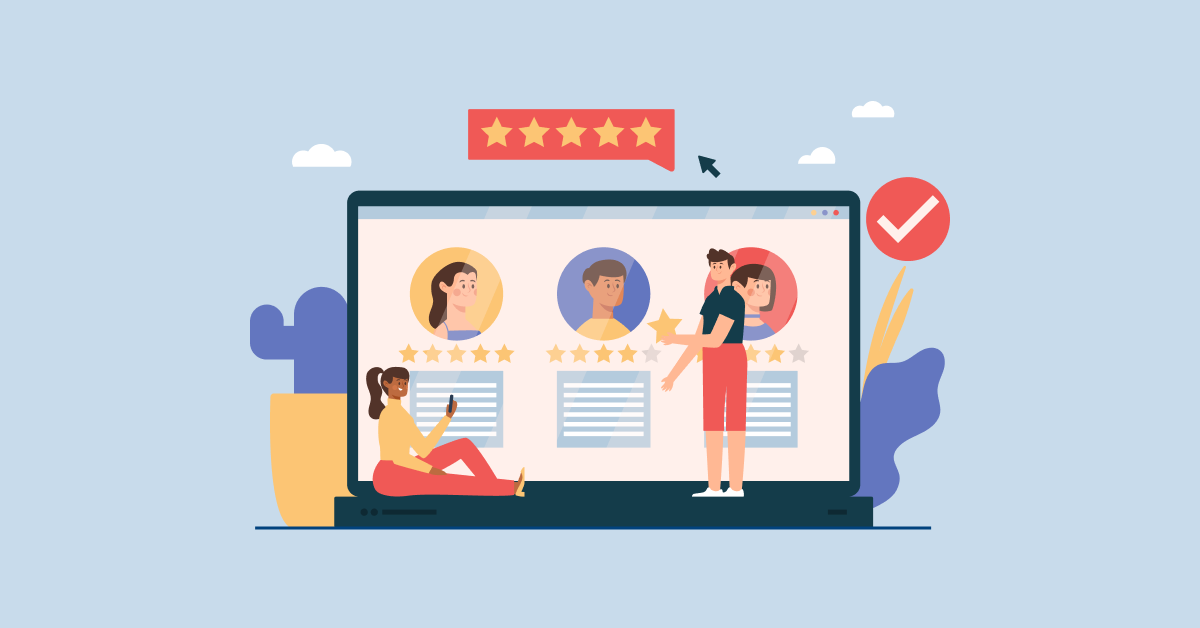
Discover valuable customer feedback examples, from product reviews to support interactions. Learn to analyze information for better products, services and customer experience.

Ever wondered what customers think about a product or service? Customer feedback is an essential tool for businesses. It provides valuable insights into what customers like and dislike about the offerings.
Customer feedback can come in many forms, such as online reviews, surveys, social media comments and direct customer interactions. It is a powerful resource that can help businesses enhance their products, services and overall customer experience. 78% of people prefer brands that collect and accept customer feedback.
The article explores various customer feedback examples and how businesses can use them to their advantage. Understanding and acting on customer feedback is key to building a loyal customer base.
Customer feedback examples are comments, suggestions and opinions provided by customers about their experience with an offering. The feedback can come in various forms. It includes online reviews, surveys, social media comments and direct interactions with customer service representatives. Customer feedback is vital for businesses to understand preferences and enhance customer experiences.
Think of customer feedback as a continuous conversation between your business and customers where every interaction becomes a learning opportunity. The ongoing dialogue helps companies identify blind spots in their service delivery while building stronger relationships through active listening and responsive improvements.
Key components:
There are several different types of customer feedback that businesses can gather. Each provides a unique perspective on the customer experience.

Product feedback represents direct customer insights about your software or service functionality and performance. Companies need the feedback to understand user pain points and identify improvement opportunities that drive customer satisfaction.
Product feedback can be used strategically to prioritize development roadmaps and allocate resources effectively. Teams analyze patterns in user suggestions to build features that genuinely address customer needs rather than assumptions.
Best Practices:
In-app feedback is collected while users are actively using your app, making it easy for them to share what’s working and what’s not. It helps you understand their experience in the moment, so you can spot issues and make improvements faster.
Companies need in-app feedback because it eliminates recall bias and captures authentic user emotions during actual product usage. The feedback reflects genuine reactions to specific features rather than general impressions formed from distant memory.
Common use cases for in-app feedback collection include:
Users appreciate it when companies make feedback submission effortless and demonstrate that their input drives meaningful product improvements.
Website feedback encompasses all customer communications received through your company’s web presence, including contact forms and live chat interactions. It helps businesses understand if there are any navigation issues and content gaps that affect conversion rates significantly.
Companies need website feedback to optimize their digital presence and reduce friction in customer journeys throughout the buying process. Understanding where users struggle on your site enables targeted improvements that boost engagement metrics and increase sales conversion rates.
Three effective methods for collecting website feedback include:
How do you prevent website feedback from becoming overwhelming noise rather than actionable insights that drive meaningful improvements? The key lies in implementing smart filtering systems that automatically categorize feedback by topic and priority while ensuring responses reach the right teams based on customer value.
Net Promoter Score measures customer loyalty by asking how likely customers are to recommend your business to others. Companies need NPS because it provides a standardized metric that correlates strongly with business growth and customer retention rates.
The NPS scale ranges from 0 to 10, where customers rating 9-10 become promoters while those rating 0-6 are detractors. The simple scoring system allows businesses to calculate their net score by subtracting the percentage of detractors from promoters.
Essential follow-up questions that reveal deeper insights about customer sentiment include:
Social media comments represent unsolicited customer opinions shared publicly across platforms like Facebook, Twitter and Instagram. Companies need social media feedback because it captures authentic customer sentiment and influences potential buyers through peer recommendations.
Social media feedback can be used proactively to address customer concerns publicly and demonstrate responsive customer service. Companies monitor mentions and hashtags to capitalize on positive conversations that build brand reputation.
Pro tips:
Collecting customer feedback is an essential component of any successful business strategy. Here are five reasons why it is important to collect customer feedback:
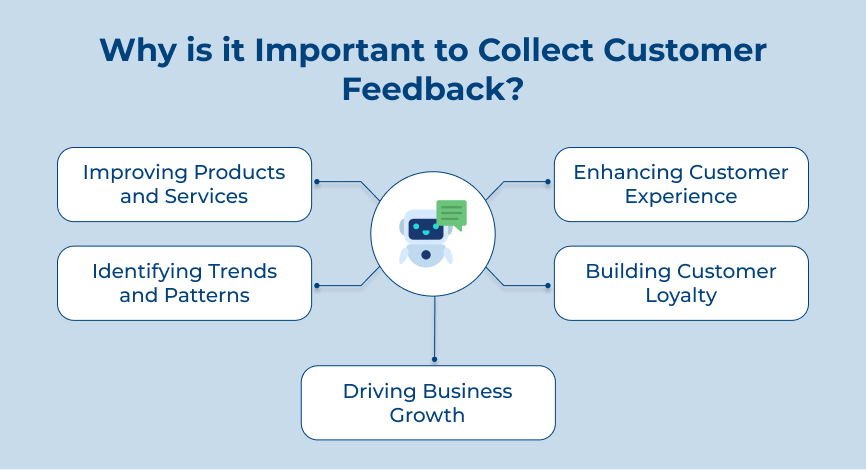
1. Improving products and services: Customer feedback provides valuable insights into what customers like and dislike about the products or services. Businesses can collect feedback to pinpoint areas for improvement and adjust to better serve customer needs.
2. Enhancing customer experience: Customer feedback allows businesses to understand the customer experience and identify improvement areas. Addressing customer concerns, can enhance the customer experience and build long-lasting relationships.
3. Identifying trends and patterns: Analyzing customer feedback can help businesses identify trends and patterns in customer behavior. Understanding the patterns can help make informed decisions about marketing strategies, product offerings and customer service initiatives.
4. Building customer loyalty: Actively responding to customer feedback and showing customers that their opinions are important to the business. It can build trust among customers, leading to repeat business and positive word-of-mouth referrals.
5. Driving business growth: Customer review examples can provide valuable insights into new market opportunities and emerging trends. Listening to the customers and adapting the business strategies accordingly can position the business for growth.
We have compiled a list of the best customer feedback examples to help businesses make the most of their customer feedback.
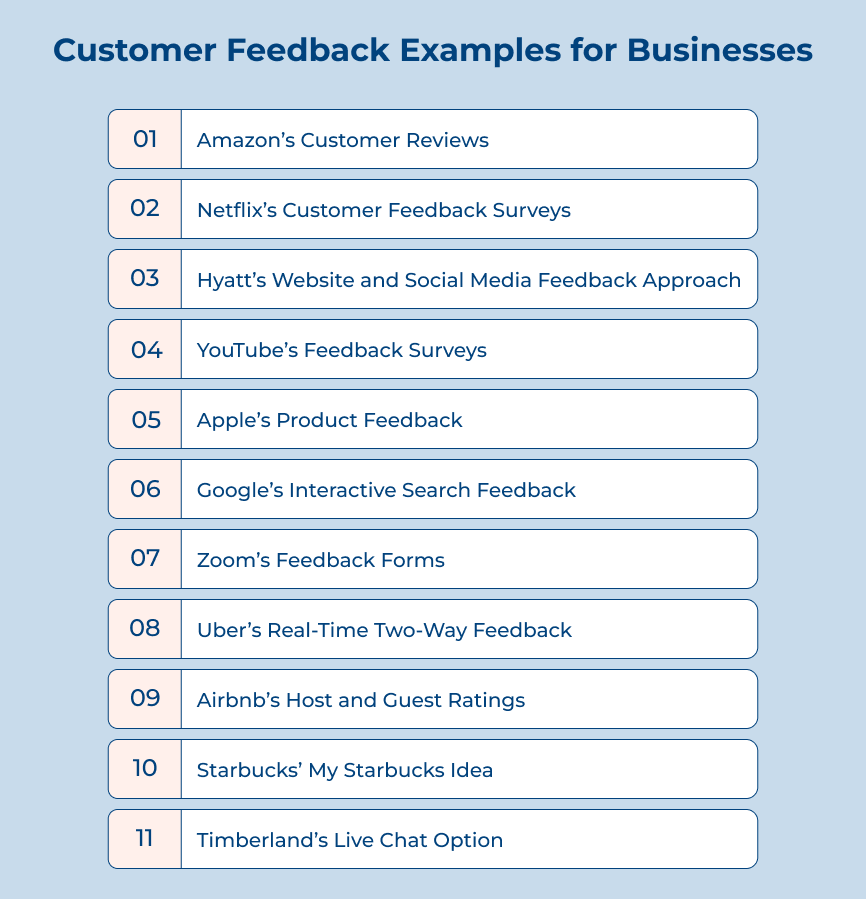
Amazon’s Customer Reviews
Amazon collects customer feedback through its comprehensive review system that allows buyers to rate products and write detailed reviews after purchase. Customers can rate products on a five-star scale and include photos and videos, while verified purchase badges ensure authenticity.
The customer review system has transformed Amazon into a trusted marketplace where buyer decisions rely heavily on peer recommendations. The feedback creates a self-regulating quality control mechanism that helps maintain high product standards and builds consumer confidence across all categories.
Netflix’s Customer Feedback Surveys
Netflix gathers customer feedback through targeted surveys that appear after users finish watching content or when they cancel their subscriptions. These surveys ask specific questions about content preferences, viewing habits and reasons for dissatisfaction using multiple-choice formats.
Netflix uses the feedback to refine its content recommendation algorithms and guide original content investment decisions. The insights help them understand viewing patterns and preferences, which directly influence their multi-billion dollar content strategy.
Hyatt’s Website and Social Media Feedback Approach
Hyatt collects customer feedback through multiple digital touchpoints, including their website, contact forms, social media monitoring and post-stay email surveys. They actively engage with customers on platforms while encouraging detailed feedback through their official channels and review platforms.
Adopting a comprehensive feedback approach has enabled Hyatt to build stronger customer relationships and address service issues proactively. The multi-channel strategy helps them capture feedback at different stages of the customer journey, leading to improved service delivery and enhanced guest satisfaction.
Apple’s Product Feedback
Apple collects product feedback through its dedicated feedback portal, where customers can submit suggestions, bug reports and feature requests for various products. Users can categorize their feedback by product type and provide detailed descriptions of issues or enhancement ideas directly to Apple’s development teams.
Apple’s structured feedback collection has contributed to its reputation for continuous product improvement and customer-focused innovation. The feedback directly influences product updates, software enhancements and new feature development, ensuring that customer needs remain central to their design philosophy.
Uber’s Real-Time Two-Way Feedback
Uber collects feedback through their bidirectional rating system, where both riders and drivers rate each other immediately after each trip completion. The app prompts users to provide star ratings and optional comments while also allowing them to report specific issues or compliments about their experience.
The real-time feedback system holds both drivers and riders accountable, leading to more respectful interactions and consistent service. Allowing both parties to rate each other has enabled Uber to quickly spot problems and take action where needed.
Let’s explore some essential tips to craft feedback requests that truly resonate with your audience and drive your business forward.
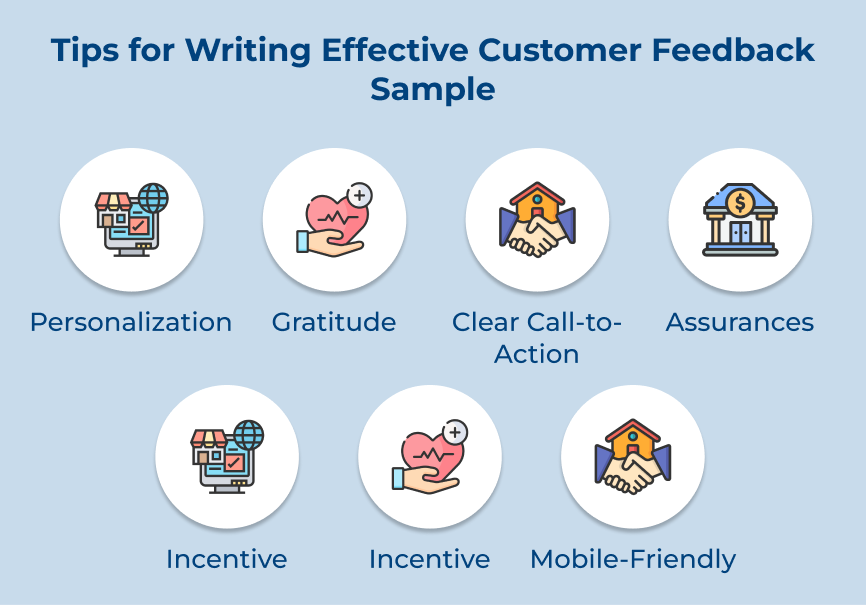
One of the key factors in writing an effective customer feedback sample is personalization. Address the customer by name and tailor the feedback request to their specific experience with the offerings. The personal touch shows the customer that the business values their opinion and is genuinely interested in their feedback.
Expressing gratitude is another important element of writing an effective customer feedback sample. Begin the request by thanking the customer for their business and taking the time to provide feedback. A simple “thank you” goes a long way in making the customer feel appreciated and more inclined to provide honest feedback.
A clear call-to-action is essential in any customer feedback sample. Clearly outline what the business would like the customer to do. It can be filling out a survey, leaving a review, or providing specific feedback on their experience. Make it easy for the customer to understand what is expected of them and how they can provide their feedback.
When requesting customer feedback, provide assurances that their feedback is important and will be taken into consideration. Assure customers that their feedback will be used to improve products and services. It will encourage customers to provide honest and constructive feedback.
While not necessary, offering incentives can encourage more customers to provide feedback. It could be in the form of discounts, coupons, or entry into a prize draw. Just be sure that the incentive is aligned with the brand and does not come across as bribery.
When crafting customer feedback samples, be sure to maintain the brand voice. If the brand is known for being friendly and informal, the feedback samples should reflect that tone. If the brand is more professional, the feedback samples should be written in a more formal tone. Consistency in the brand voice will help customers feel more connected and will make the feedback samples more impactful.
Customer feedback samples must be mobile-friendly. Many customers now access surveys and feedback forms on their smartphones or tablets. Make sure the form is optimized for mobile devices with easy-to-read fonts, clear buttons and a user-friendly interface. It will improve the customer experience and increase response rates.
The following are the essential tools that will streamline your feedback collection process, enabling you to capture valuable insights with ease.
Veemo Survey is a customer satisfaction platform that allows businesses to collect customer feedback across various channels such as email, SMS, chat and social media. It provides a centralized platform for managing customer thoughts, making it easier for businesses to respond to customer needs in real time.
Key features:

Omni24 operates as a comprehensive customer experience platform that specializes in omnichannel communication and feedback collection across multiple touchpoints. The platform integrates live chat, helpdesk ticketing and knowledge base functionality while providing robust feedback collection tools that help businesses gather actionable customer insights.
Key features:
SurveyMonkey is a popular online survey tool that allows businesses to create and send surveys to customers. Businesses can customize the surveys with different question types, themes and branding options. SurveyMonkey also provides real-time analytics to help businesses analyze and understand the feedback received.
UserVoice is a customer feedback tool that helps businesses collect, organize and prioritize customer feedback. Businesses can create feedback forums, gather ideas from customers and track feedback trends over time. The tool also provides reporting features to help businesses make data-driven decisions based on customer feedback.
Zendesk is a customer service software that includes a feedback feature to capture customer opinions and suggestions. Businesses can create feedback forms, track feedback history and integrate customer feedback with support tickets. The tool also offers automation features to streamline the feedback collection process.
Customer feedback examples serve as a roadmap to success for any business. Listening to the opinions of the customers can improve the offerings, enhance customer satisfaction and drive growth. Analyzing customer feedback is crucial for making informed decisions and staying competitive. So, don’t underestimate the power of customer feedback. It can be the key to unlocking the business’s full potential and achieving long-term success.
Customer feedback is a valuable tool for improving the business. Start by collecting feedback through surveys, reviews and social media. Analyze the feedback to identify common themes and areas for improvement. Use the feedback to make changes to the products, services and customer experience. Regularly communicate with customers about changes based on their feedback to show that their opinions are valued.
Good customer feedback is specific, detailed and genuine. Let’s consider a customer saying, “I loved how easy it was to navigate the website and find exactly what I was looking for. The checkout process was smooth and my order arrived sooner than expected. I had a fantastic shopping experience.” It provides valuable insights for businesses to improve their products and services.
One example of positive feedback to customers is thanking them for their loyalty and patronage. Expressing appreciation for their continued support can make customers feel valued and appreciated. Businesses are building a positive relationship and encouraging repeat business by acknowledging their contribution to the business. Remember, a little gratitude can go a long way in customer satisfaction.
When writing customer feedback, be specific and honest about the experience. Start by expressing the satisfaction level, then mention the likes and dislikes about the product or service. Provide suggestions for improvement and include any relevant details. Keep it concise and to the point for clarity.
When collecting feedback, it’s important to avoid biased questions that lead respondents to give a certain answer. Avoid defensive reactions to negative feedback, as it can hinder growth and improvement. Don’t overlook feedback from a certain demographic or customer segment, as it can provide valuable insights. Avoid dismissing or ignoring feedback altogether, as it can lead to missed opportunities for growth.
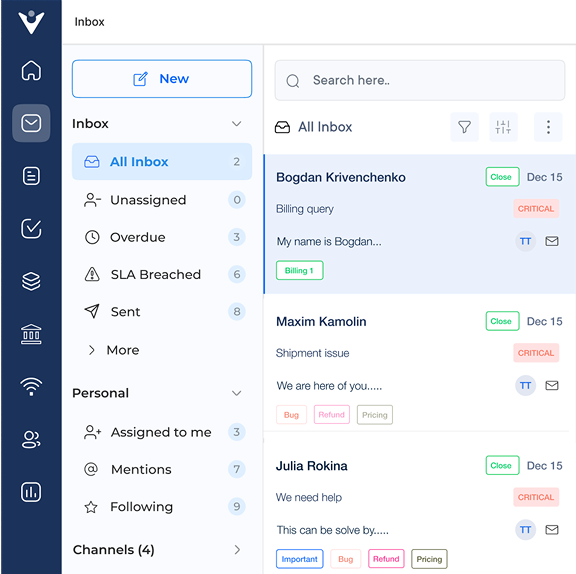
Market better, sell faster and support smarter with Veemo’s Conversation Customer Engagement suite of products.
Unify all your customer data in one platform to deliver contextual responses. Get a 360 degree view of the customer lifecycle without switching tools.
Connect with the tools you love to reduce manual activities and sync your business workflows for a seamless experience.
 https://veemo.io/wp-content/uploads/2024/12/customer-service-response-time.png
1256
2400
indrasish5342@gmail.com
https://veemo.io/wp-content/uploads/2024/11/veemo.svg
indrasish5342@gmail.com2025-10-17 10:51:142025-12-15 05:49:239 Effective Tips to Reduce Customer Service Response Time
https://veemo.io/wp-content/uploads/2024/12/customer-service-response-time.png
1256
2400
indrasish5342@gmail.com
https://veemo.io/wp-content/uploads/2024/11/veemo.svg
indrasish5342@gmail.com2025-10-17 10:51:142025-12-15 05:49:239 Effective Tips to Reduce Customer Service Response Time https://veemo.io/wp-content/uploads/2024/10/How-to-Create-Knowledge-Base.png
1257
2400
Vikas Sachan
https://veemo.io/wp-content/uploads/2024/11/veemo.svg
Vikas Sachan2024-10-21 12:24:342025-12-15 05:58:17How to Create a Knowledge Base in 9 Easy Steps: The Ultimate Guide
https://veemo.io/wp-content/uploads/2024/10/How-to-Create-Knowledge-Base.png
1257
2400
Vikas Sachan
https://veemo.io/wp-content/uploads/2024/11/veemo.svg
Vikas Sachan2024-10-21 12:24:342025-12-15 05:58:17How to Create a Knowledge Base in 9 Easy Steps: The Ultimate Guide https://veemo.io/wp-content/uploads/2024/02/Live-Chat-for-Sales.png
628
1200
Vikas Sachan
https://veemo.io/wp-content/uploads/2024/11/veemo.svg
Vikas Sachan2024-10-21 11:31:222025-12-15 05:58:19How to Use Live Chat for Sales? 7 Proven Ways to Grow Revenue
https://veemo.io/wp-content/uploads/2024/02/Live-Chat-for-Sales.png
628
1200
Vikas Sachan
https://veemo.io/wp-content/uploads/2024/11/veemo.svg
Vikas Sachan2024-10-21 11:31:222025-12-15 05:58:19How to Use Live Chat for Sales? 7 Proven Ways to Grow RevenueGrow Customer Relationships and stronger team collaboration with our range of products across the Conversational Engagement Suite.

 Top 10 Tips for Optimizing Chatbot UI: Examples & Best Practices
Scroll to top
Top 10 Tips for Optimizing Chatbot UI: Examples & Best Practices
Scroll to top